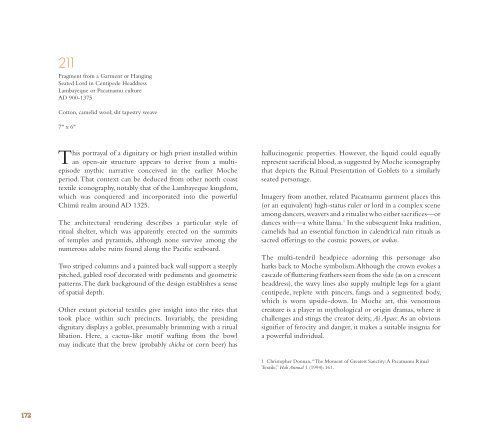Create successful ePaper yourself
Turn your PDF publications into a flip-book with our unique Google optimized e-Paper software.
211<br />
Fragment from a Garment or Hanging<br />
Seated Lord in Centipede Headdress<br />
Lambayeque or Pacatnamu culture<br />
AD 900-1375<br />
Cotton, camelid wool; slit tapestry weave<br />
7" x 6"<br />
This portrayal of a dignitary or high priest installed within<br />
an open-air structure appears to derive from a multiepisode<br />
mythic narrative conceived in <strong>the</strong> earlier Moche<br />
period. That context can be deduced from o<strong>the</strong>r north coast<br />
textile iconography, notably that of <strong>the</strong> Lambayeque kingdom,<br />
which was conquered and incorporated into <strong>the</strong> powerful<br />
Chimú realm around AD 1325.<br />
The architectural rendering describes a particular style of<br />
ritual shelter, which was apparently erected on <strong>the</strong> summits<br />
of temples and pyramids, although none survive among <strong>the</strong><br />
numerous adobe ruins found along <strong>the</strong> Pacific seaboard.<br />
Two striped columns and a painted back wall support a steeply<br />
pitched, gabled roof decorated with pediments and geometric<br />
patterns. The dark background of <strong>the</strong> design establishes a sense<br />
of spatial depth.<br />
O<strong>the</strong>r extant pictorial textiles give insight into <strong>the</strong> rites that<br />
took place within such precincts. Invariably, <strong>the</strong> presiding<br />
dignitary displays a goblet, presumably brimming with a ritual<br />
libation. Here, a cactus-like motif wafting from <strong>the</strong> bowl<br />
may indicate that <strong>the</strong> brew (probably chicha or corn beer) has<br />
hallucinogenic properties. However, <strong>the</strong> liquid could equally<br />
represent sacrificial blood, as suggested by Moche iconography<br />
that depicts <strong>the</strong> Ritual Presentation of Goblets to a similarly<br />
seated personage.<br />
Imagery from ano<strong>the</strong>r, related Pacatnamu garment places this<br />
(or an equivalent) high-status ruler or lord in a complex scene<br />
among dancers, weavers and a ritualist who ei<strong>the</strong>r sacrifices—or<br />
dances with—a white llama. 1 In <strong>the</strong> subsequent Inka tradition,<br />
camelids had an essential function in calendrical rain rituals as<br />
sacred offerings to <strong>the</strong> cosmic powers, or wakas.<br />
The multi-tendril headpiece adorning this personage also<br />
harks back to Moche symbolism. Although <strong>the</strong> crown evokes a<br />
cascade of fluttering fea<strong>the</strong>rs seen from <strong>the</strong> side (as on a crescent<br />
headdress), <strong>the</strong> wavy lines also supply multiple legs for a giant<br />
centipede, replete with pincers, fangs and a segmented body,<br />
which is worn upside-down. In Moche art, this venomous<br />
creature is a player in mythological or origin dramas, where it<br />
challenges and stings <strong>the</strong> creator deity, Ai Apaec. As an obvious<br />
signifier of ferocity and danger, it makes a suitable insignia for<br />
a powerful individual.<br />
1 Christopher Donnan, “The Moment of Greatest Sanctity: A Pacatnamu Ritual<br />
Textile,” Hali Annual 1 (1994): 161.<br />
172







